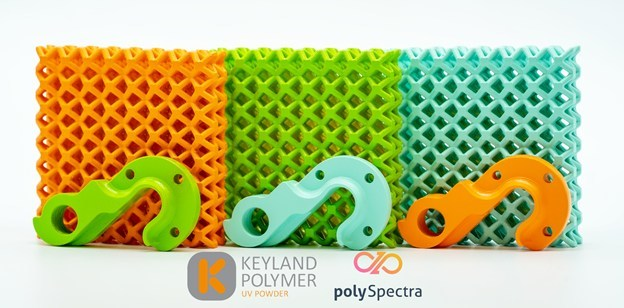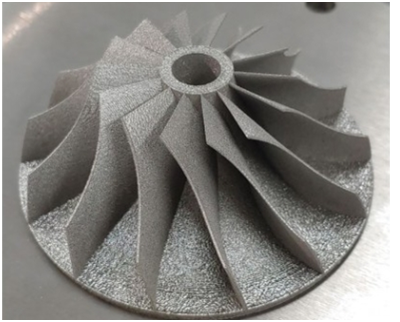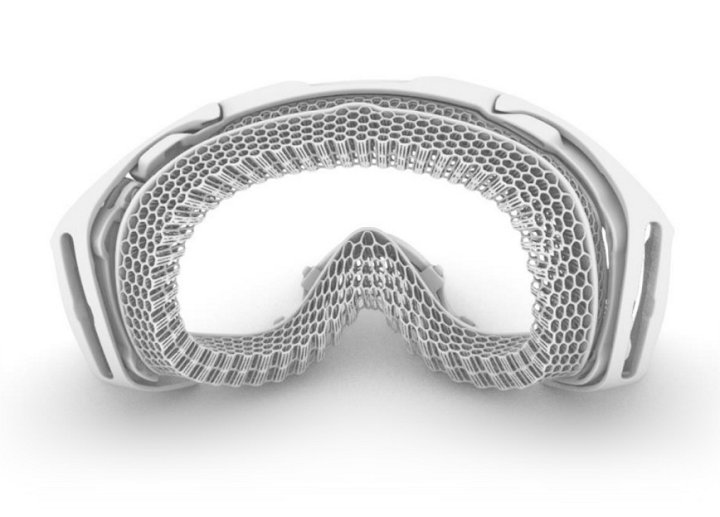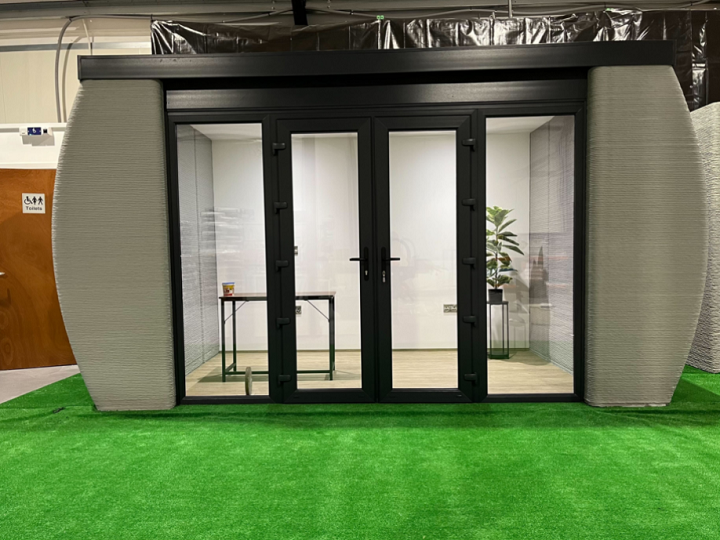In today’s 3D Printing News Briefs, polySpectra and Keyland Polymer announced a strategic partnership, and KAERI developed a 3D printer for making larger nuclear components. Researchers in Singapore created a low-cost imaging system to check the quality of metal 3D printed parts. In interesting 3D printed objects, UMaine says its new 3D printed USMC vessel is the largest of its kind. Oeschler 3D printed more comfortable ski goggles. Finally, Versarien has launched its lifestyle pods, 3D printed out of graphene-enhanced cement.
polySpectra & Keyland Polymer 3D Printing Consumer Goods in Any Color
First up, advanced materials company polySpectra and Keyland Polymer, which develops, manufactures, and sells UV curable powder coatings, have announced a strategic partnership. Together, the two will work to provide Keyland’s UVMax powder coatings to polySpectra’s engineering-grade COR Alpha 3D printed parts, enabling 3D printing of end-use polymer consumer goods of any color and shape, for any application. Keyland’s color-matching capabilities, and the texture and surface color of its UVMax coating, can be specifically tailored to make parts 3D printed out of polySpectra’s COR family of materials seem identical to parts made with traditional manufacturing.
“The promise of 3D printing has always been to help innovators to quickly and efficiently make their ideas real. For 3D printing to make the transition into true production-grade additive manufacturing — designers, inventors and engineers need to be able to trust that their printed parts will have the accuracy, aesthetics and durability required to use in their application. We are now making good on that promise,” said polySpectra Founder and CEO Raymond Weitekamp.
“We have spent years searching for a scalable & durable coating solution that would enable our customers to apply their favorite brand colors to COR Alpha parts. With UVMax®, we finally found the solution.”
KAERI’s 3D Printer for Large Nuclear Components
The Korea Atomic Energy Research Institute (KAERI) has announced the development of a new powder bed fusion (PBF) 3D printer that can fabricate a large-scale component up to the size of one meter. The institute says that the maximum laser scanner spread is about 50 cm, and that while it’s “practically impossible” to create a scanner larger than that, they went a different route. KAERI developed parallel extension, which connects two separate laser source-scanner sets, and was able to print five different nickel alloy-based prototypes with its new system. The applications include small modular reactor development, reverse engineering, space powder reactor component development, and more.
“One laser source fixed at a position transmits light with uniformity to cover 0.5 m by 0.5 m through a reflective scanner. In our development, two laser sources are used along with two scanners to cover 1 m by 1 m, and additional 0.5 m connection can be repeated and the component size is expected to increase to several meters,” KAERI said.
NTU Singapore Develops Low-Cost Imaging Method for Metal 3D Printing

NTU Singapore researchers developed new low-cost system to check quality of 3D printed metal parts. Image courtesy of NTU Singapore.
Researchers from Nanyang Technological University, Singapore (NTU Singapore) created a fast, low-cost imaging system that can analyze the structure and quality of metal 3D printed parts. Engineers typically use scanning electron microscopes to look at the sizes, shapes, and atomic lattice orientation of microscopic crystal networks in metal 3D printed alloys to see how strong and tough they are, but this method is costly and time-consuming. The NTU Singapore team’s new system offers the same information, but at less cost and in just minutes.
The system is made up of a flashlight, optical camera, and notebook computer, which runs a proprietary machine learning software that the team developed. Once the surface of the printed item is chemical-treated to reveal its microstructure, the flashlight illuminates it from various angles and the camera takes many optical images. Then, the software analyzes the patterns produced by the light reflecting off the surface of the metal crystals to determine their size, shape, and orientation. The whole thing only takes 15 minutes, and could be really helpful in industries like aerospace and defense.
UMaine’s Large 3D Printed USMC Vessel
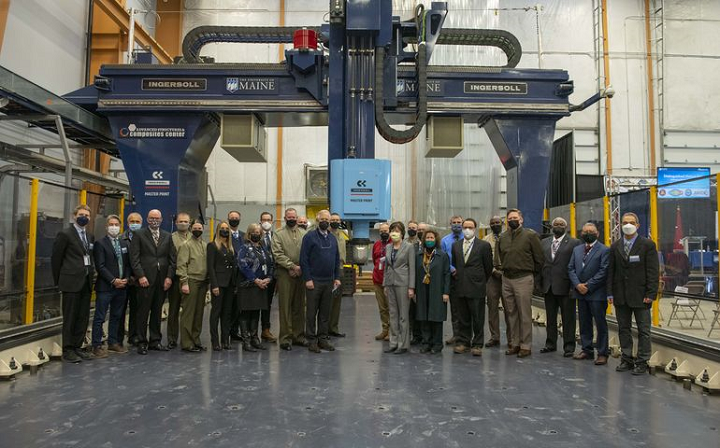
U.S. Sens. Susan Collins and Angus King, U.S. Department of Defense leadership, and University of Maine officials participated in a Feb. 25 unveiling of the UMaine Advanced Structures and Composites Center’s production of the world’s largest 3D printed logistics vessel for the U.S. Department of Defense. Image courtesy of UMaine.
In 2019, the University of Maine’s Advanced Structures and Composites Center debuted what was called the world’s largest 3D printer, which has both additive and subtractive capabilities. It was used to print a non-functional 25-foot boat, which, at the time, was the largest 3D printed object in the world. Now, UMaine has unveiled two new prototype vessels 3D printed on its giant printer, the longer of which the university says is now considered the world’s largest 3D printed object. The vessels, 3D printed out of a polymeric composite for the US Department of Defense, can transport two shipping containers, and a Marine rifle squad with three days worth of supplies. They can be connected to maximize transport capability, and will be tested by the US Marine Corps. This project was part of a collaboration between the center and the Marine Corps Systems Command’s Advanced Manufacturing Operations Cell, which conducts testing and analysis to leverage advanced manufacturing.
“Two years ago, we demonstrated that it was possible to 3D-print a 25-foot patrol vessel in three days. Since then, partnering with the DOD, we have been improving material properties, speeding up the printing process and connecting our printer with high-performance computers that can monitor the print,” said Habib Dagher, the Executive Director of UMaine’s Advanced Structures and Composites Center.
Oeschler’s 3D Printed Ski Goggles
Plastics technology supplier OECHSLER AG recently used 3D printing to set new and improved standards in the sporting goods sector, by making the frame for a pair of ski goggles more comfortable and functional, and reducing its number of components from 13 down to one. The case study explains that OECHSLER redesigned the ski goggles, deciding to eliminate all the mounting steps. This meant it would have to reconstruct foams by lattice (rather than gluing them together), reduce the design to a single frame, and integrate rotatable parts into the 3D printed frame. The team also had to ensure that the lattice wasn’t too thick or thin.
CT was used to scan all the parts for reverse engineering, and the components were then reconstructed in a vector-based program to create a print file for both the lattice and solid parts. Everything was 3D printed out of TPU material. On the first try, due to the amount of post-processing, the frame was too stiff, which made the handles less flexible. So OECHSLER optimized the print file and adjusted the post-processing to increase the lattice structure’s flexibility, which was no easy feat. But they were able to complete the project—all the way from product design to production—in one week, and the new frame for the ski goggles is now more comfortable and flexible, and only features one component. By eliminating the mounting steps, the company was able to reduce the amount of material used, as well as the production costs.
Versarien Launches Lunar 3D Printed Lifestyle Pods
Finally, advanced engineering materials group Versarien plc announced the launch of its Lunar lifestyle pod, which is the company’s first 3D printed concrete product made with its graphene-enhanced cement material Cementene. The pods were designed with innovation and sustainability in mind, which is more important than ever as the construction industry accounts for roughly 8% of global CO2 emissions. The first of these Lunar pods was unveiled at Versarien’s production facilities in Longhope, Gloucestershire, and they can be used as a leisure room, gym, studio, or office. The pods feature full-height glazed windows and doors, and shows just how precise, detailed, and flexible concrete 3D printing can be. Additionally, the company says buildings can be completed faster by incorporating graphene into concrete, as less materials are required to achieve a similar structural performance to what regular concrete offers.
“This launch represents the first application of a technology that has the potential to change the way the world views construction and property renovation. Lunar doesn’t just provide convenience for homeowners, it is also a beacon of hope for those who don’t have access to basic amenities like shelter. Our 3D printed concrete can build pods for those suffering hardship, whilst creating a circular economy for houses, giving individuals in more developed countries the opportunity to chop and change and ‘lift and shift’ their homes,” said Neill Ricketts, CEO of Versarien. “Versarien is driving this innovation and we look forward to seeing the impact this technology can have in the world around us.”
Subscribe to Our Email Newsletter
Stay up-to-date on all the latest news from the 3D printing industry and receive information and offers from third party vendors.
You May Also Like
3D Printing News Briefs, April 13, 2024: Robotics, Orthotics, & Hypersonics
In 3D Printing News Briefs today, we’re focusing first on robotics, as Carnegie Mellon University’s new Robotics Innovation Center will house several community outreach programs, and Ugogo3D is now working...
Rail Giant Alstom Saves $15M with 3D Printing Automation Software 3D Spark
3D Spark has entered into a three-year deal with the rail giant Alstom. Alstom, a transport behemoth with annual revenues of $16 billion, specializes in the manufacture of trains, trams,...
Meltio Expands Global Reach with New Partnerships in the Americas and Europe
Spanish 3D printing manufacturer Meltio has expanded its sales network across the globe. With the addition of three new partners in the United States, Brazil, Argentina, and Italy, Meltio aims...
3D Printing Webinar and Event Roundup: April 7, 2024
Webinars and events in the 3D printing industry are picking back up this week! Sea-Air-Space is coming to Maryland, and SAE International is sponsoring a 3D Systems webinar about 3D...


